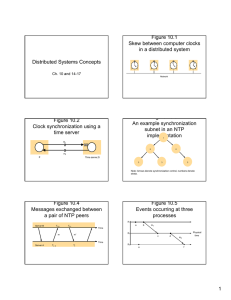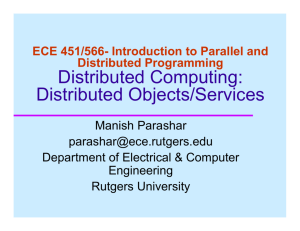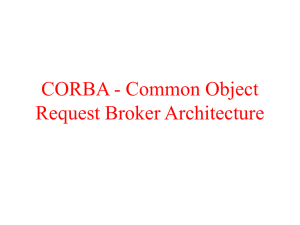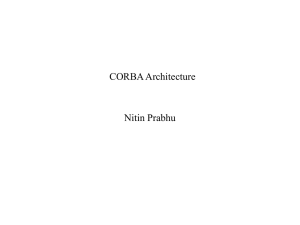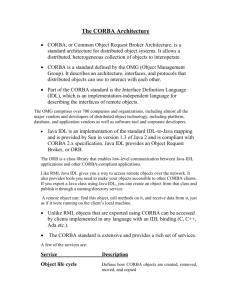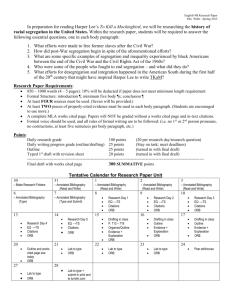Systems Area: OS and Networking
advertisement
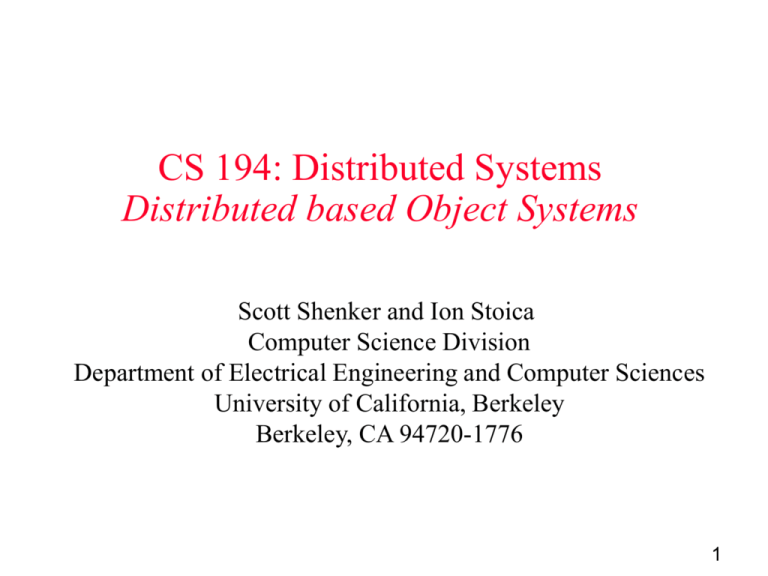
CS 194: Distributed Systems
Distributed based Object Systems
Scott Shenker and Ion Stoica
Computer Science Division
Department of Electrical Engineering and Computer Sciences
University of California, Berkeley
Berkeley, CA 94720-1776
1
Outline
Common Object Request Broker Architecture (CORBA)
Distributed Common Object Model (DCOM)
2
Introduction to CORBA
The Object Management Group (OMG) was formed in
1989. Its aims were:
- to make better use of distributed systems
- to use object-oriented programming
- to allow objects in different programming languages to
communicate with one another
The object request broker (ORB) enables clients to
invoke methods in a remote object
CORBA is a specification of an architecture supporting
this.
- CORBA 1 in 1990 and CORBA 2 in 1996.
3
•
Generic Architecture
Client
Server
Object
Object
Middleware
4
CORBA Architecture
Remote-object: object implementation resides in server’s
address space
Server
Client
Java Object
C++ Object
Skeleton
Stub
Object Adapter
ORB
IIOP
ORB
5
Stub
Provides interface between client object and ORB
Marshalling: client invocation
Unmarshalling: server response
Server
Client
Java Object
C++ Object
Skeleton
Stub
Object Adapter
ORB
IIOP
ORB
6
Skeleton
Provides iterface between server object and ORB
Unmarshaling: client invocation
Marshaling: server response
Server
Client
Java Object
C++ Object
Skeleton
Stub
Object Adapter
ORB
IIOP
ORB
7
(Portable) Object Adapter (POA)
Register class implementations
Creates and destroys objects
Handles method invokation
Handles client authentication and access control
Server
Client
Java Object
C++ Object
Skeleton
Stub
Object Adapter
ORB
IIOP
ORB
8
Object Request Broker (ORB)
Communication infrastructure sending messages between
objects
Communication type:
- GIOP (General Inter-ORB Protocol)
- IIOP (Internet Inter-ORB Protocol) (GIOP on TCP/IP)
Server
Client
Java Object
C++ Object
Skeleton
Stub
Object Adapter
ORB
IIOP
ORB
9
CORBA Object
Server
CORBA
Interoperable Object Reference
Object
Interface
IDL
C++/Java
Implementation
Servant
10
Interoperable Object Reference (IOR)
•
•
Uniquely identifies an object
Example
• IOR:000000000000001049444c3a5472697669616c3a312e300000000001
000000000000007c000102000000000d3135322e38312e342e3131300000
048000000025abacab3131303033383632313336005f526f6f74504f41000
0cafebabe3bd5b8780000000000000000000001000000010000002c00000
000000100010000000400010020000101090001010005010001000101090
00000020001010005010001
Server
CORBA
Object
Interoperable Object Reference
Interface
IDL
C++/Java
Implementation
Servant
11
Interface Definition Language (IDL)
Describes interface
Language independent
Client and server platform independent
Server
CORBA
Object
Interoperable Object Reference
Interface
IDL
C++/Java
Implementation
Servant
12
Overall CORBA Architecture
Client
C++ Object
Implementation Interface
repository
repository
IDL
Server
Java Object
Interface repository
the interface repository provides information about registered IDL interfaces to
Skeleton
clients and servers that require it.
Stub
Object Adapter
Implementation repository
IIOP
activates registered servers on demand and locates running servers
ORB
ORB
uses the object adapter name to register and activate servers
13
Example of CORBA Services
Naming: Keeps track of association between object
names and their reference. Allows ORB to locate
referenced objects
Life Cycle: Handles the creation, copying, moving,
and deletion objects
Trader: A “yellow pages” for objects. Lets you find
them by the services they provide
Event: Facilitates asynchronous communications
through events
Concurrency: Manages locks so objects can share
resources
Query: Locates objects by specified search criteria
…
14
Object Invocation Models
Invocation models supported in CORBA
Request type
Failure semantics
Description
Synchronous
At-most-once
Caller blocks until a response is
returned or an exception is
raised
One-way
Best effort delivery
Caller continues immediately
without waiting for any response
from the server
Deferred
synchronous
At-most-once
Caller continues immediately
and can later block until
response is delivered
15
Event and Notification Services (1)
Push model
Each event is associated with a single data item
Events are delivered through a channel
Consumers need to register to a channel
16
Event and Notification Services (2)
Pull model
17
Messaging (1)
Asynchronous method invocation
Example:
void sendcb_add(in int i, in int j); // called by client
void replycb_add(in int ret_val, in int k); // called by client’s ORB
18
Messaging (2)
Pulling model for asynchronous method invocation
Example:
void sendpoll_add(in int i, in int j); // called by client
void replycall_add(out int ret_val, out int k); // called by the client
19
Interoperability
Allow multi-vendor ORB implementations to
communicate with each other
General Inter-ORB Protocol (GIOP) message types
Message type
Originator
Description
Request
Client
Contains an invocation request
Reply
Server
Contains the response to an invocation
LocateRequest
Client
Contains a request on the exact location of an
object
LocateReply
Server
Contains location information on an object
CancelRequest
Client
Indicates client no longer expects a reply
CloseConnection
Both
Indication that connection will be closed
MessageError
Both
Contains information on an error
Fragment
Both
Part (fragment) of a larger message
20
Object References (1)
The organization of an IOR with specific information for
IIOP
21
Object References (2)
Indirect binding in CORBA
22
Fault Tolerance: Object Groups
Object groups: one or mode identical copies of same object
Replication transparent to client
Replication strategies
- Primary-backup, Quorum, ….
23
Security
Transparency: application-level objects should be unaware
of security services which are used
Control: client/object should be able to specify security
requirements
Security polices: specified by policy objects
Administrative domain where client/server is executed
determines set of security services
24
Secure Object Invocation in CORBA
25
CORBA Application
1)
2)
3)
4)
Define interface using IDL
Compile interface
Implement interface
Instantiate server:
•
Register object as a CORBA object
5) Instantiate client:
•
•
Invoke CORBA object
Example using a Java client and server
26
CORBA IDL interfaces Shape and
ShapeList
struct
struct GraphicalObject
Rectangle{
{
long width;
string type;
long height;
Rectangle enclosing;
long x; this struct is used in
boolean isFilled;
long y; defining another struct.
};this struct is used as a parameter or
};
result type in methods in the remote
interface Shape {
interfaces
long getVersion() ;
GraphicalObject getAllState() ;
// returns state of the GraphicalObject
};
an interface specifies a name and a set of methods
sequences and arrays in typedefs
typedef sequence <Shape, 100> All;
interface ShapeList {
interface ShapeList
exception FullException{ };
Shape newShape(in GraphicalObject g) raises (FullException);
All allShapes();
// returns sequence of remote object references
long getVersion() ;
the};parameter of newShape is an in parameter
Exceptions defined by raises and
and of type Graphical Object The return value
Figure
is an extra
out 17.1
parameter of type Shape. No
classes can be passed as arguments or results
set by throw. They can have
arguments.
27
IDL Interface
The interface compiler is called idltojava
When given an IDL interface, it produces
-
Server skeletons for each class (e.g. _ShapeListImplBase)
Proxy classes (e.g. _ShapeListStub)
A Java class for each struct e.g. Rectangle, GraphicalObject
Helper classes (narrow method) and holder classes (for out
arguments)
- The equivalent Java interfaces (e.g. ShapeList below)
28
The ShapeListServant class of the Java server
program for the CORBA interface ShapeList
A Java server has classes for its
import org.omg.CORBA.*;
IDL interfaces (e.g. Shape and
class ShapeListServant extends _ShapeListImplBase {
ShapeList). Here is the class
ORB theOrb;
ShapeListServant
private Shape theList[];
A servant class extends the corresponding
private int version;
skeleton class (e.g. ShapeListImplBase)
private static int n=0;
public ShapeListServant(ORB orb){
theOrb = orb;
CORBA objects are instances of servant
// initialize the other instance variables
classes.
}
public Shape newShape(GraphicalObject g) throws ShapeListPackage.FullException {
version++;
Shape s = new ShapeServant( g, version);
if(n >=100) throw new ShapeListPackage.FullException();
theList[n++] = s;
A servant class implements the methods in the
theOrb.connect(s);
interface (ShapeList). newShape is a factory
return s;
method. It creates new CORBA objects. It uses
}
the connect method to inform the ORB about
public Shape[] allShapes(){ ... }
the new CORBA object. (it has a remote
public int getVersion() { ... }
}
reference module)
29
Java class ShapeListServer (the
server class)
1.
2.
3.
4.
5.
import org.omg.CosNaming.*;
The server class contains the main method
itimport
getsorg.omg.CosNaming.NamingContextPackage.*;
a reference to the Naming Service
narrows
it to NamingContext- from Object
import org.omg.CORBA.*;
makes
a NameComponent
public class
ShapeListServer { containing the it creates and initialises the ORB
public
static void main(String args[]) {
name
“ShapeList”
makes try{
a path
ORB orb = ORB.init(args, null);
uses rebind to register the name and
ShapeListServant shapeRef = new ShapeListServant(orb);
object reference
orb.connect(shapeRef);
org.omg.CORBA.Object objRef =
it creates an instance of ShapeListServant class - a
orb.resolve_initial_references("NameService");
Java
object - which is made a CORBA object
NamingContext ncRef
= NamingContextHelper.narrow(objRef);
using
the connect method to register
NameComponent ncby
= new
NameComponent("ShapeList",
""); it with the
ORB= {nc};
NameComponent path[]
ncRef.rebind(path, shapeRef);
java.lang.Object sync = new java.lang.Object();
synchronized (sync) { sync.wait();}
it waits for client requests
} catch (Exception e) { ... }
}
30
}
Java client program for CORBA
interfaces Shape and ShapeList
import org.omg.CosNaming.*;
1. it contacts the NamingService for initial context
import org.omg.CosNaming.NamingContextPackage.*;
2. Narrows it to NamingContext
import org.omg.CORBA.*;
it creates
and initialises an ORB
3. It makes a name
component
public class ShapeListClient{
4. It makes a path
public static void main(String args[])
{ a reference to the CORBA object called
5. It gets
try{
“ShapeList”, using resolve and narrows it
ORB orb = ORB.init(args, null);
org.omg.CORBA.Object objRef =
orb.resolve_initial_references("NameService");
it uses one of the remote references in the array to
it invokes the allShapes method in the CORBA object to get an array
NamingContext ncRef
NamingContextHelper.narrow(objRef);
invoke= the
getAllState method in the corresponding
containing remote references to all of the GraphicalObjects currently
NameComponentCORBA
nc = new
NameComponent("ShapeList",
object
whose type is Shape "");
stored by the server
NameComponentthe
path
[] = returned
{ nc }; is of type GraphicalObject
value
ShapeList shapeListRef =
ShapeListHelper.narrow(ncRef.resolve(path));
Shape[] sList = shapeListRef.allShapes();
GraphicalObject g = sList[0].getAllState();
} catch(org.omg.CORBA.SystemException e) {...}
}
31
Outline
Common Object Request Broker Architecture (CORBA)
Distributed Common Object Model (DCOM)
32
Distributed Component Object
Model (DCOM)
Designed by Microsoft
Based on Component Object Model (COM)
Addresses issues such as:
- Interoperability
• Different applications, platforms, languages
- Versioning
• Compatibility between a new version of a server and old
versions of clients
New interfaces should preserve the old interface
- Naming
• Use Globally unique identifiers
33
History
DDE OLE1 COM OLE DCOM
Dynamic Data Exchange (DDE)
- For data exchange between any application through clipboard package
- Originally for Windows 2.1
Object Linking and Embedding (OLE v1.0)
-
A compound document can embed objects belonging to other applications
E.g., an Excel spreadsheet in a Word document
An embedded object is linked to its original application
Restricted to document objects
34
History (continued)
Component Object Model (COM)
- Interoperability of components
- Ability to share non-document based components
- Object-based technology
• Identity, polymorphism (multiple interfaces to a component),
interface inheritance
OLE
- Layered on top of COM (and DCOM)
- Links the application layer to the underlying COM architecture
35
Object Model
The difference between language-defined (CORBA) and
binary interfaces (DCOM)
36
DCOM Properties
Distributed shared memory management
- DCOM provides interfaces for distributed components to share
memory
Network interoperability and transparency
Dynamic loading and unloading
- DCOM manages reference counts to objects
- Unloads objects whose reference count is 0
Status reporting
- Of remote execution using HRESULT struct
37
DCOM Services
DCOM is responsible for initializing a connection between
components, and
- Negotiating protocols for communication
DCOM provides support for persistent storage
- Objects can persist
Components can be assigned “intelligent names” called
monikers
38
DCOM Architecture
SCM: Service Control Manager
39
Creating objects
Classes of objects have globally unique identifiers (GUIDs)
- 128 bit numbers
- Also called class ids (CLSID)
DCOM provides functions to create objects given a server
name and a class id
- The SCM on the client connects to the SCM of the server and
requests creation of the object
40
MIDL
An extension of DCE’s IDL
The MIDL compiler generates the client and server stub
files
Every DCOM interface inherits from an interface known
as IUnknown
- Interface names start with I
- IUnknown has three methods
• AddRef(), Release() and QueryInterface()
• AddRef() and Release() are used to manage reference
counts (for memory management)
41
Events
Event processing in DCOM.
42
Passing an Object Reference in DCOM
(with custom marshaling)
43
Monikers (1)
Object names (as opposed to class names) are called monikers
A moniker distinguishes one instance from another of the same
class
Monikers themselves are objects
A moniker carries enough information to locate the object it
represents
- They can also recreate the object, if it is not currently running
They have a human readable form similar to a URL. Example:
Moniker for a file object “file:c:\my documents\July
Report.doc”
44
Monikers (2)
When a client passes a moniker to access an object,
COM looks up a Running Object Table (ROT) for the
moniker name
- If it exists, a pointer to the object is returned
- Else, a new object instance is created, its state is restored, its
reference is entered in ROT, and a pointer to the object is
returned to the client
• Monikers contain reference to the object’s persisted state
45
Fault Tolerance
Supported by mean of transactions
Developer specify that a series of method invocations
should be grouped in a transaction
Attribute value
Description
REQUIRES_NEW
A new transaction is always started at each
invocation
REQUIRED
A new transaction is started if not already done so
SUPPORTED
Join a transaction only if caller is already part of one
NOT_SUPPORTED
Never join a transaction
DISABLED
Never join a transaction, even if told to do so
46
Declarative Security (1)
Authentication levels in DCOM
Authentication
level
NONE
Description
No authentication is required
CONNECT
Authenticate client when first connected to server
CALL
Authenticate client at each invocation
PACKET
PACKET_INTEGRI
TY
Authenticate all data packets
PACKET_PRIVACY
Authenticate data packets and do integrity check
Authenticate, integrity-check, and encrypt data
packets
47
Declarative Security (2)
Impersonation levels in DCOM
Impersonation
level
ANONYMOUS
IDENTIFY
IMPERSONATE
DELEGATE
Description
The client is completely anonymous to the
server
The server knows the client and can do access
control checks
The server can invoke local objects on behalf of
the client
The server can invoke remote objects on behalf
of the client
48
Programmatic Security (1)
Allow applications to security levels, and choose between
different security services
Default authentication services supported in DCOM:
Service
Description
NONE
No authentication
DCE_PRIVATE
DCE authentication based on shared keys
DCE_PUBLIC
DEC authentication based on public keys
WINNT
Windows NT security
GSS_KERBEROS
Kerberos authentication
49
Programmatic Security (2)
Default authorization services supported in DCOM
Service
NONE
NAME
DCE
Description
No authorization
Authorization based on the client's identity
Authorization using DEC Privilege Attribute
Certificates (PACs)
50
CORBA vs. DCOM (1)
Issue
Design goals
Object model
Services
Interfaces
Sync.
communication
Async.
communication
Callbacks
Events
Messaging
Object server
Directory service
Trading service
CORBA
Interoperability
Remote objects
Many of its own
IDL based
DCOM
Functionality
Remote objects
From environment
Binary
Yes
Yes
Yes
Yes
Yes
Yes
Yes
Flexible (POA)
Yes
yes
Yes
Yes
Yes
Hard-coded
Yes
No
51
CORBA vs. DCOM (2)
Issue
Naming service
Location service
Object reference
Synchronization
Replication
support
Transactions
Fault tolerance
Recovery support
Security
CORBA
Yes
No
Object's location
Transactions
Separate server
DCOM
Yes
No
Interface pointer
Transactions
None
Yes
By replication
Yes
Various
mechanisms
Yes
By transactions
By transactions
Various
mechanisms
52
